NMIH106 Essentials: Mrs. London’s Ischaemic CVA Case Study Analysis
VerifiedAdded on 2023/04/22
|14
|4060
|431
Case Study
AI Summary
This case study provides an in-depth analysis of Mrs. London, a 75-year-old female recovering from a left-sided ischaemic CVA. The study begins with an overview of the pathophysiology of stroke, focusing on the specifics of Mrs. London's condition, including her expressive dysphasia and right-sided hemiparesis. It explores the impact of these conditions on her ability to communicate and perform daily living activities. The study then details the nursing care rationale, emphasizing the importance of maintaining a safe environment and promoting mobility, considering her Glasgow Coma Scale score and the necessary diagnostic tests. It outlines specific nursing interventions designed to address her communication challenges and physical limitations, taking into account her psychological and emotional well-being. The case study also touches upon the role of modifiable risk factors and the need for a comprehensive care plan to support Mrs. London's recovery and eventual discharge.
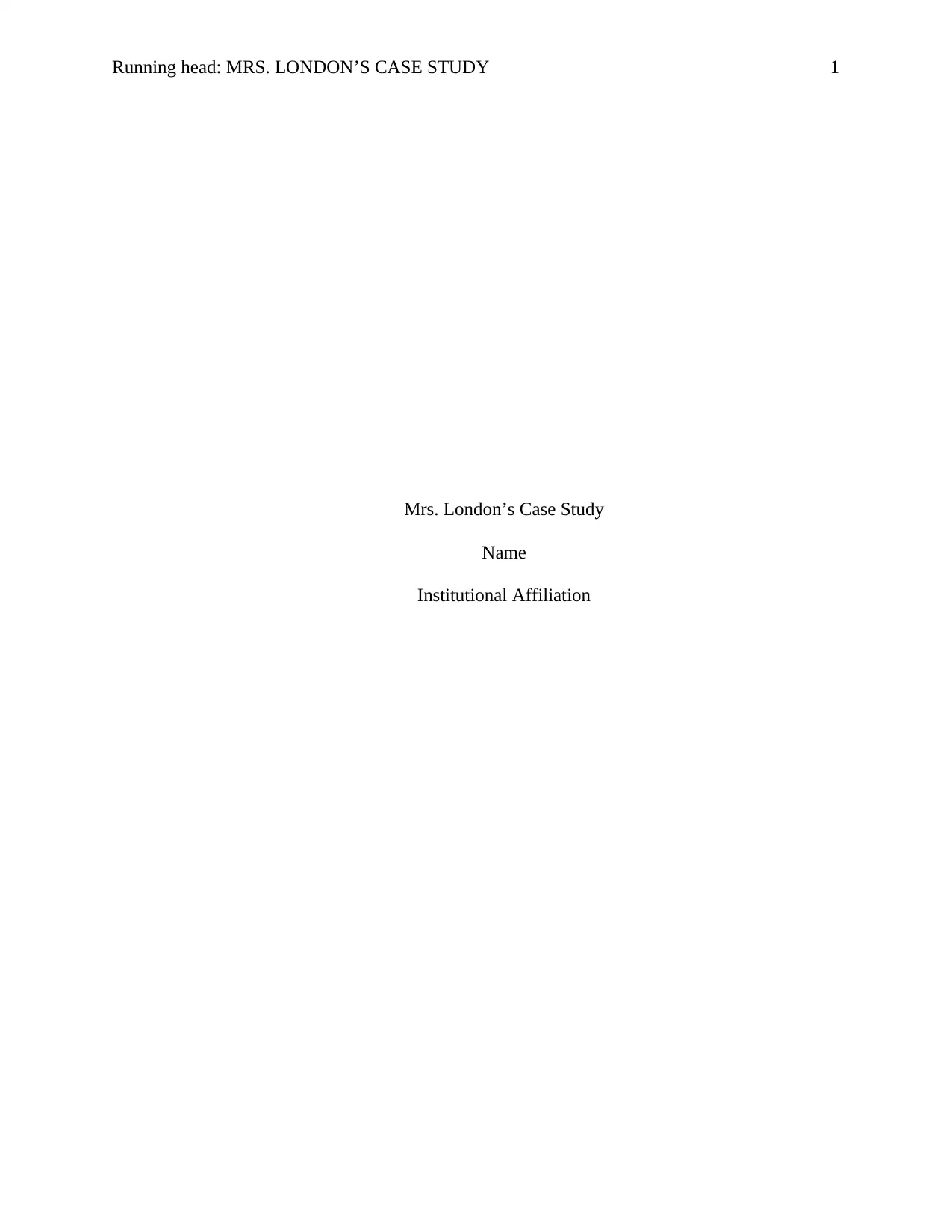
Running head: MRS. LONDON’S CASE STUDY 1
Mrs. London’s Case Study
Name
Institutional Affiliation
Mrs. London’s Case Study
Name
Institutional Affiliation
Paraphrase This Document
Need a fresh take? Get an instant paraphrase of this document with our AI Paraphraser
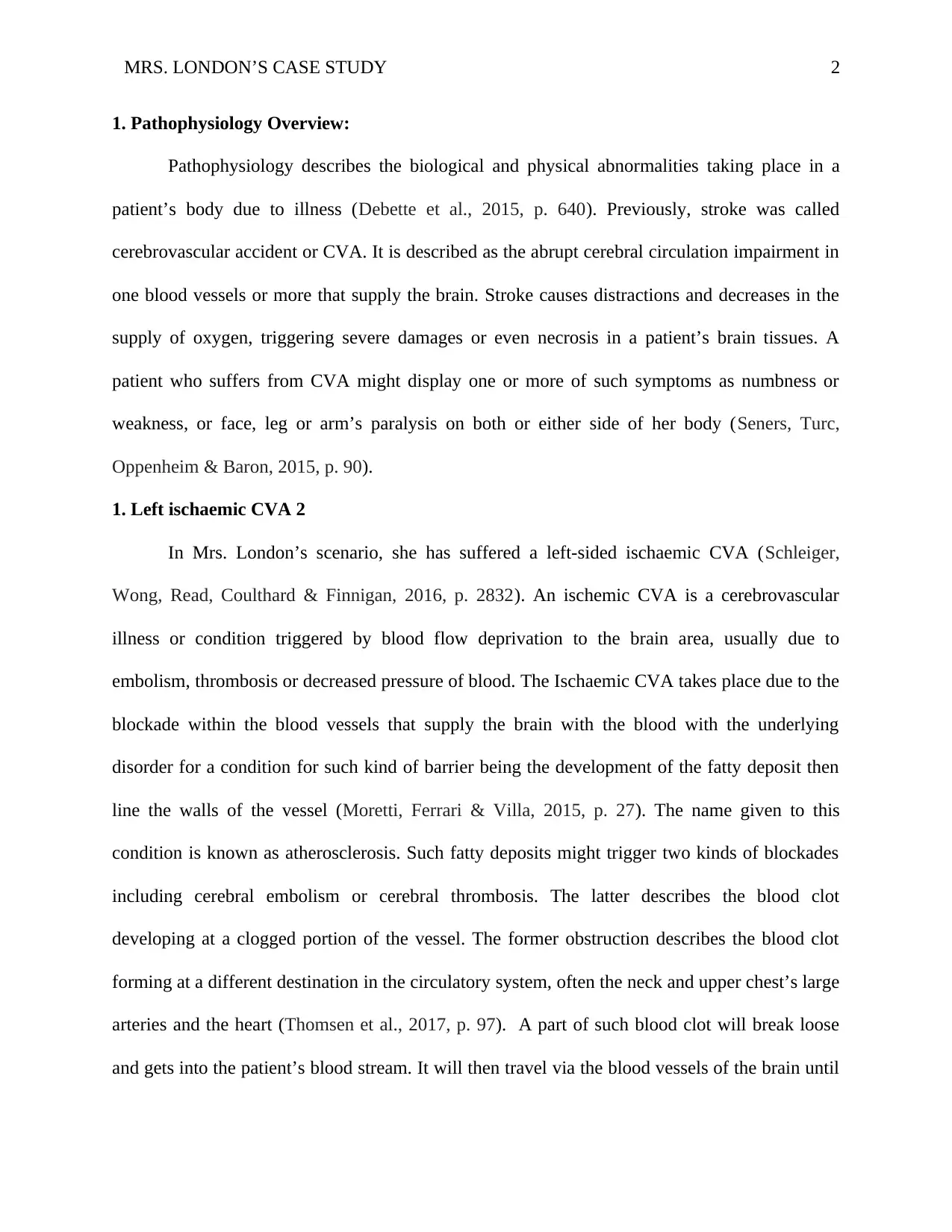
MRS. LONDON’S CASE STUDY 2
1. Pathophysiology Overview:
Pathophysiology describes the biological and physical abnormalities taking place in a
patient’s body due to illness (Debette et al., 2015, p. 640). Previously, stroke was called
cerebrovascular accident or CVA. It is described as the abrupt cerebral circulation impairment in
one blood vessels or more that supply the brain. Stroke causes distractions and decreases in the
supply of oxygen, triggering severe damages or even necrosis in a patient’s brain tissues. A
patient who suffers from CVA might display one or more of such symptoms as numbness or
weakness, or face, leg or arm’s paralysis on both or either side of her body (Seners, Turc,
Oppenheim & Baron, 2015, p. 90).
1. Left ischaemic CVA 2
In Mrs. London’s scenario, she has suffered a left-sided ischaemic CVA (Schleiger,
Wong, Read, Coulthard & Finnigan, 2016, p. 2832). An ischemic CVA is a cerebrovascular
illness or condition triggered by blood flow deprivation to the brain area, usually due to
embolism, thrombosis or decreased pressure of blood. The Ischaemic CVA takes place due to the
blockade within the blood vessels that supply the brain with the blood with the underlying
disorder for a condition for such kind of barrier being the development of the fatty deposit then
line the walls of the vessel (Moretti, Ferrari & Villa, 2015, p. 27). The name given to this
condition is known as atherosclerosis. Such fatty deposits might trigger two kinds of blockades
including cerebral embolism or cerebral thrombosis. The latter describes the blood clot
developing at a clogged portion of the vessel. The former obstruction describes the blood clot
forming at a different destination in the circulatory system, often the neck and upper chest’s large
arteries and the heart (Thomsen et al., 2017, p. 97). A part of such blood clot will break loose
and gets into the patient’s blood stream. It will then travel via the blood vessels of the brain until
1. Pathophysiology Overview:
Pathophysiology describes the biological and physical abnormalities taking place in a
patient’s body due to illness (Debette et al., 2015, p. 640). Previously, stroke was called
cerebrovascular accident or CVA. It is described as the abrupt cerebral circulation impairment in
one blood vessels or more that supply the brain. Stroke causes distractions and decreases in the
supply of oxygen, triggering severe damages or even necrosis in a patient’s brain tissues. A
patient who suffers from CVA might display one or more of such symptoms as numbness or
weakness, or face, leg or arm’s paralysis on both or either side of her body (Seners, Turc,
Oppenheim & Baron, 2015, p. 90).
1. Left ischaemic CVA 2
In Mrs. London’s scenario, she has suffered a left-sided ischaemic CVA (Schleiger,
Wong, Read, Coulthard & Finnigan, 2016, p. 2832). An ischemic CVA is a cerebrovascular
illness or condition triggered by blood flow deprivation to the brain area, usually due to
embolism, thrombosis or decreased pressure of blood. The Ischaemic CVA takes place due to the
blockade within the blood vessels that supply the brain with the blood with the underlying
disorder for a condition for such kind of barrier being the development of the fatty deposit then
line the walls of the vessel (Moretti, Ferrari & Villa, 2015, p. 27). The name given to this
condition is known as atherosclerosis. Such fatty deposits might trigger two kinds of blockades
including cerebral embolism or cerebral thrombosis. The latter describes the blood clot
developing at a clogged portion of the vessel. The former obstruction describes the blood clot
forming at a different destination in the circulatory system, often the neck and upper chest’s large
arteries and the heart (Thomsen et al., 2017, p. 97). A part of such blood clot will break loose
and gets into the patient’s blood stream. It will then travel via the blood vessels of the brain until
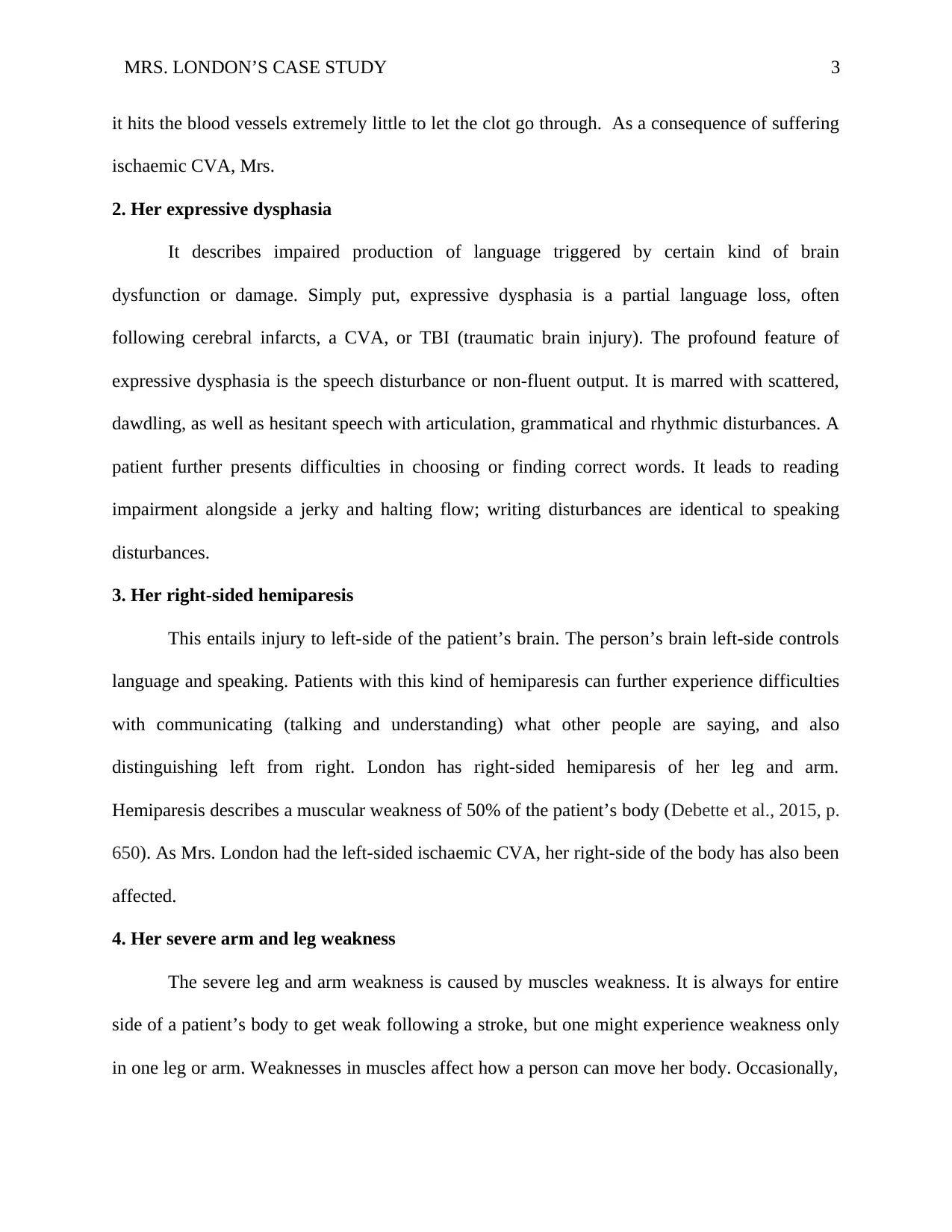
MRS. LONDON’S CASE STUDY 3
it hits the blood vessels extremely little to let the clot go through. As a consequence of suffering
ischaemic CVA, Mrs.
2. Her expressive dysphasia
It describes impaired production of language triggered by certain kind of brain
dysfunction or damage. Simply put, expressive dysphasia is a partial language loss, often
following cerebral infarcts, a CVA, or TBI (traumatic brain injury). The profound feature of
expressive dysphasia is the speech disturbance or non-fluent output. It is marred with scattered,
dawdling, as well as hesitant speech with articulation, grammatical and rhythmic disturbances. A
patient further presents difficulties in choosing or finding correct words. It leads to reading
impairment alongside a jerky and halting flow; writing disturbances are identical to speaking
disturbances.
3. Her right-sided hemiparesis
This entails injury to left-side of the patient’s brain. The person’s brain left-side controls
language and speaking. Patients with this kind of hemiparesis can further experience difficulties
with communicating (talking and understanding) what other people are saying, and also
distinguishing left from right. London has right-sided hemiparesis of her leg and arm.
Hemiparesis describes a muscular weakness of 50% of the patient’s body (Debette et al., 2015, p.
650). As Mrs. London had the left-sided ischaemic CVA, her right-side of the body has also been
affected.
4. Her severe arm and leg weakness
The severe leg and arm weakness is caused by muscles weakness. It is always for entire
side of a patient’s body to get weak following a stroke, but one might experience weakness only
in one leg or arm. Weaknesses in muscles affect how a person can move her body. Occasionally,
it hits the blood vessels extremely little to let the clot go through. As a consequence of suffering
ischaemic CVA, Mrs.
2. Her expressive dysphasia
It describes impaired production of language triggered by certain kind of brain
dysfunction or damage. Simply put, expressive dysphasia is a partial language loss, often
following cerebral infarcts, a CVA, or TBI (traumatic brain injury). The profound feature of
expressive dysphasia is the speech disturbance or non-fluent output. It is marred with scattered,
dawdling, as well as hesitant speech with articulation, grammatical and rhythmic disturbances. A
patient further presents difficulties in choosing or finding correct words. It leads to reading
impairment alongside a jerky and halting flow; writing disturbances are identical to speaking
disturbances.
3. Her right-sided hemiparesis
This entails injury to left-side of the patient’s brain. The person’s brain left-side controls
language and speaking. Patients with this kind of hemiparesis can further experience difficulties
with communicating (talking and understanding) what other people are saying, and also
distinguishing left from right. London has right-sided hemiparesis of her leg and arm.
Hemiparesis describes a muscular weakness of 50% of the patient’s body (Debette et al., 2015, p.
650). As Mrs. London had the left-sided ischaemic CVA, her right-side of the body has also been
affected.
4. Her severe arm and leg weakness
The severe leg and arm weakness is caused by muscles weakness. It is always for entire
side of a patient’s body to get weak following a stroke, but one might experience weakness only
in one leg or arm. Weaknesses in muscles affect how a person can move her body. Occasionally,
⊘ This is a preview!⊘
Do you want full access?
Subscribe today to unlock all pages.

Trusted by 1+ million students worldwide
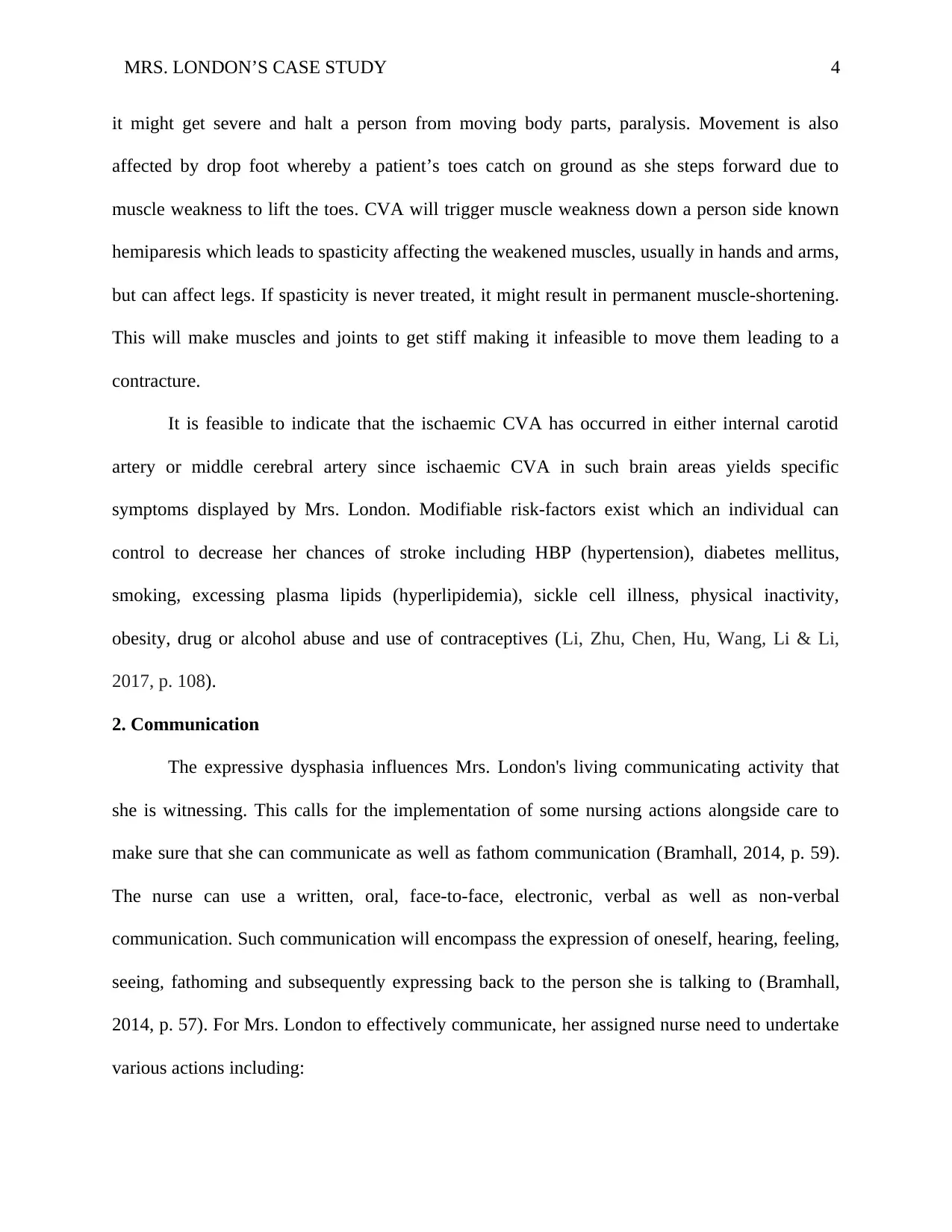
MRS. LONDON’S CASE STUDY 4
it might get severe and halt a person from moving body parts, paralysis. Movement is also
affected by drop foot whereby a patient’s toes catch on ground as she steps forward due to
muscle weakness to lift the toes. CVA will trigger muscle weakness down a person side known
hemiparesis which leads to spasticity affecting the weakened muscles, usually in hands and arms,
but can affect legs. If spasticity is never treated, it might result in permanent muscle-shortening.
This will make muscles and joints to get stiff making it infeasible to move them leading to a
contracture.
It is feasible to indicate that the ischaemic CVA has occurred in either internal carotid
artery or middle cerebral artery since ischaemic CVA in such brain areas yields specific
symptoms displayed by Mrs. London. Modifiable risk-factors exist which an individual can
control to decrease her chances of stroke including HBP (hypertension), diabetes mellitus,
smoking, excessing plasma lipids (hyperlipidemia), sickle cell illness, physical inactivity,
obesity, drug or alcohol abuse and use of contraceptives (Li, Zhu, Chen, Hu, Wang, Li & Li,
2017, p. 108).
2. Communication
The expressive dysphasia influences Mrs. London's living communicating activity that
she is witnessing. This calls for the implementation of some nursing actions alongside care to
make sure that she can communicate as well as fathom communication (Bramhall, 2014, p. 59).
The nurse can use a written, oral, face-to-face, electronic, verbal as well as non-verbal
communication. Such communication will encompass the expression of oneself, hearing, feeling,
seeing, fathoming and subsequently expressing back to the person she is talking to (Bramhall,
2014, p. 57). For Mrs. London to effectively communicate, her assigned nurse need to undertake
various actions including:
it might get severe and halt a person from moving body parts, paralysis. Movement is also
affected by drop foot whereby a patient’s toes catch on ground as she steps forward due to
muscle weakness to lift the toes. CVA will trigger muscle weakness down a person side known
hemiparesis which leads to spasticity affecting the weakened muscles, usually in hands and arms,
but can affect legs. If spasticity is never treated, it might result in permanent muscle-shortening.
This will make muscles and joints to get stiff making it infeasible to move them leading to a
contracture.
It is feasible to indicate that the ischaemic CVA has occurred in either internal carotid
artery or middle cerebral artery since ischaemic CVA in such brain areas yields specific
symptoms displayed by Mrs. London. Modifiable risk-factors exist which an individual can
control to decrease her chances of stroke including HBP (hypertension), diabetes mellitus,
smoking, excessing plasma lipids (hyperlipidemia), sickle cell illness, physical inactivity,
obesity, drug or alcohol abuse and use of contraceptives (Li, Zhu, Chen, Hu, Wang, Li & Li,
2017, p. 108).
2. Communication
The expressive dysphasia influences Mrs. London's living communicating activity that
she is witnessing. This calls for the implementation of some nursing actions alongside care to
make sure that she can communicate as well as fathom communication (Bramhall, 2014, p. 59).
The nurse can use a written, oral, face-to-face, electronic, verbal as well as non-verbal
communication. Such communication will encompass the expression of oneself, hearing, feeling,
seeing, fathoming and subsequently expressing back to the person she is talking to (Bramhall,
2014, p. 57). For Mrs. London to effectively communicate, her assigned nurse need to undertake
various actions including:
Paraphrase This Document
Need a fresh take? Get an instant paraphrase of this document with our AI Paraphraser
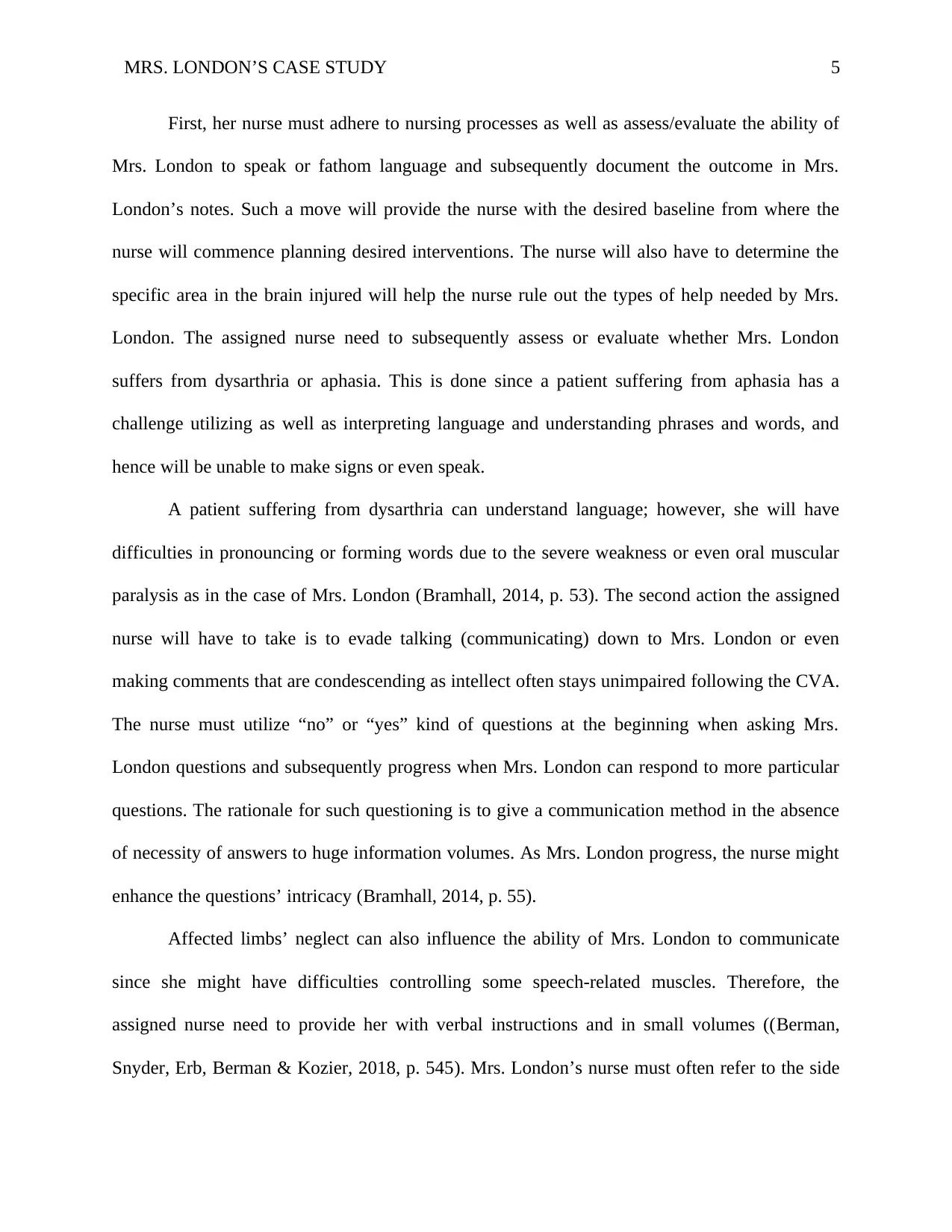
MRS. LONDON’S CASE STUDY 5
First, her nurse must adhere to nursing processes as well as assess/evaluate the ability of
Mrs. London to speak or fathom language and subsequently document the outcome in Mrs.
London’s notes. Such a move will provide the nurse with the desired baseline from where the
nurse will commence planning desired interventions. The nurse will also have to determine the
specific area in the brain injured will help the nurse rule out the types of help needed by Mrs.
London. The assigned nurse need to subsequently assess or evaluate whether Mrs. London
suffers from dysarthria or aphasia. This is done since a patient suffering from aphasia has a
challenge utilizing as well as interpreting language and understanding phrases and words, and
hence will be unable to make signs or even speak.
A patient suffering from dysarthria can understand language; however, she will have
difficulties in pronouncing or forming words due to the severe weakness or even oral muscular
paralysis as in the case of Mrs. London (Bramhall, 2014, p. 53). The second action the assigned
nurse will have to take is to evade talking (communicating) down to Mrs. London or even
making comments that are condescending as intellect often stays unimpaired following the CVA.
The nurse must utilize “no” or “yes” kind of questions at the beginning when asking Mrs.
London questions and subsequently progress when Mrs. London can respond to more particular
questions. The rationale for such questioning is to give a communication method in the absence
of necessity of answers to huge information volumes. As Mrs. London progress, the nurse might
enhance the questions’ intricacy (Bramhall, 2014, p. 55).
Affected limbs’ neglect can also influence the ability of Mrs. London to communicate
since she might have difficulties controlling some speech-related muscles. Therefore, the
assigned nurse need to provide her with verbal instructions and in small volumes ((Berman,
Snyder, Erb, Berman & Kozier, 2018, p. 545). Mrs. London’s nurse must often refer to the side
First, her nurse must adhere to nursing processes as well as assess/evaluate the ability of
Mrs. London to speak or fathom language and subsequently document the outcome in Mrs.
London’s notes. Such a move will provide the nurse with the desired baseline from where the
nurse will commence planning desired interventions. The nurse will also have to determine the
specific area in the brain injured will help the nurse rule out the types of help needed by Mrs.
London. The assigned nurse need to subsequently assess or evaluate whether Mrs. London
suffers from dysarthria or aphasia. This is done since a patient suffering from aphasia has a
challenge utilizing as well as interpreting language and understanding phrases and words, and
hence will be unable to make signs or even speak.
A patient suffering from dysarthria can understand language; however, she will have
difficulties in pronouncing or forming words due to the severe weakness or even oral muscular
paralysis as in the case of Mrs. London (Bramhall, 2014, p. 53). The second action the assigned
nurse will have to take is to evade talking (communicating) down to Mrs. London or even
making comments that are condescending as intellect often stays unimpaired following the CVA.
The nurse must utilize “no” or “yes” kind of questions at the beginning when asking Mrs.
London questions and subsequently progress when Mrs. London can respond to more particular
questions. The rationale for such questioning is to give a communication method in the absence
of necessity of answers to huge information volumes. As Mrs. London progress, the nurse might
enhance the questions’ intricacy (Bramhall, 2014, p. 55).
Affected limbs’ neglect can also influence the ability of Mrs. London to communicate
since she might have difficulties controlling some speech-related muscles. Therefore, the
assigned nurse need to provide her with verbal instructions and in small volumes ((Berman,
Snyder, Erb, Berman & Kozier, 2018, p. 545). Mrs. London’s nurse must often refer to the side
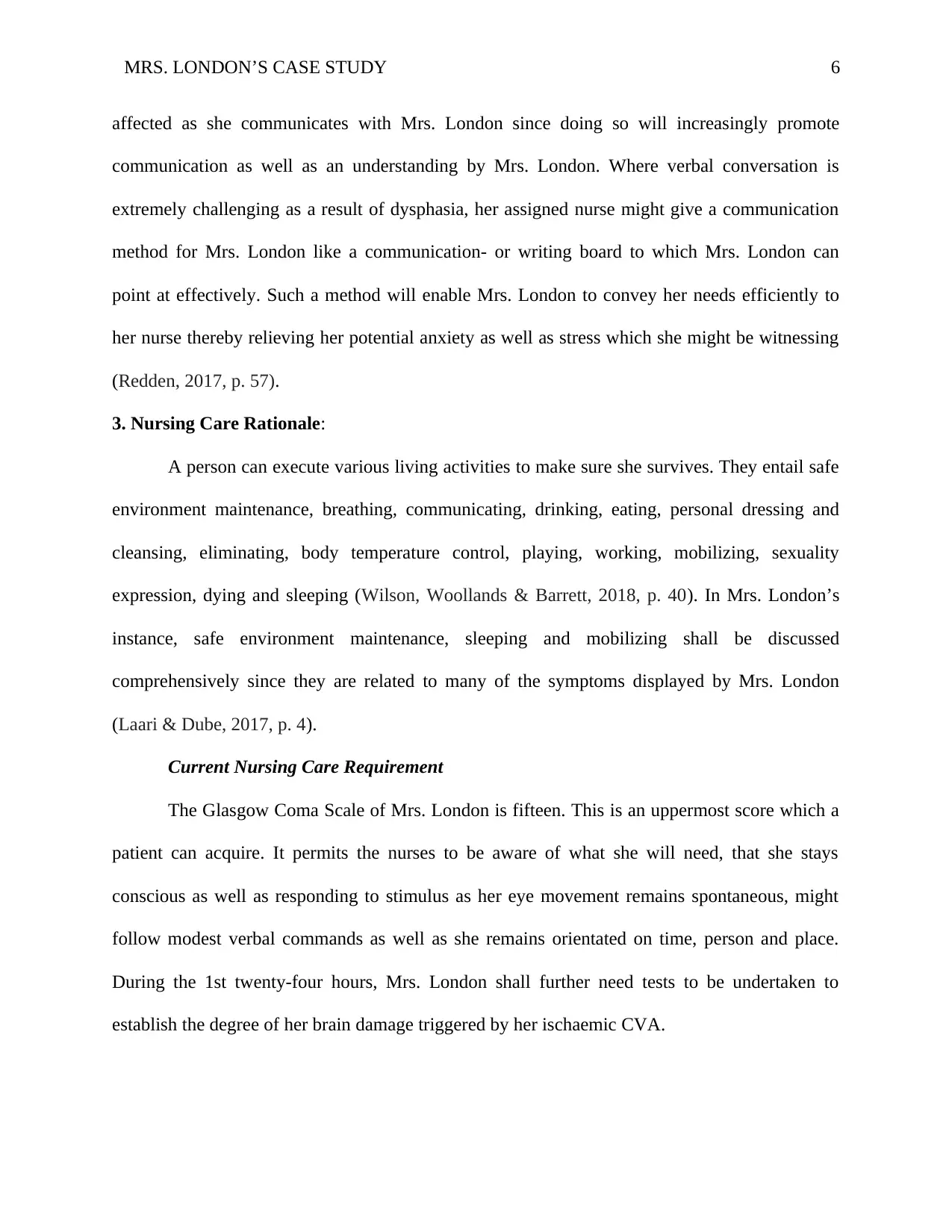
MRS. LONDON’S CASE STUDY 6
affected as she communicates with Mrs. London since doing so will increasingly promote
communication as well as an understanding by Mrs. London. Where verbal conversation is
extremely challenging as a result of dysphasia, her assigned nurse might give a communication
method for Mrs. London like a communication- or writing board to which Mrs. London can
point at effectively. Such a method will enable Mrs. London to convey her needs efficiently to
her nurse thereby relieving her potential anxiety as well as stress which she might be witnessing
(Redden, 2017, p. 57).
3. Nursing Care Rationale:
A person can execute various living activities to make sure she survives. They entail safe
environment maintenance, breathing, communicating, drinking, eating, personal dressing and
cleansing, eliminating, body temperature control, playing, working, mobilizing, sexuality
expression, dying and sleeping (Wilson, Woollands & Barrett, 2018, p. 40). In Mrs. London’s
instance, safe environment maintenance, sleeping and mobilizing shall be discussed
comprehensively since they are related to many of the symptoms displayed by Mrs. London
(Laari & Dube, 2017, p. 4).
Current Nursing Care Requirement
The Glasgow Coma Scale of Mrs. London is fifteen. This is an uppermost score which a
patient can acquire. It permits the nurses to be aware of what she will need, that she stays
conscious as well as responding to stimulus as her eye movement remains spontaneous, might
follow modest verbal commands as well as she remains orientated on time, person and place.
During the 1st twenty-four hours, Mrs. London shall further need tests to be undertaken to
establish the degree of her brain damage triggered by her ischaemic CVA.
affected as she communicates with Mrs. London since doing so will increasingly promote
communication as well as an understanding by Mrs. London. Where verbal conversation is
extremely challenging as a result of dysphasia, her assigned nurse might give a communication
method for Mrs. London like a communication- or writing board to which Mrs. London can
point at effectively. Such a method will enable Mrs. London to convey her needs efficiently to
her nurse thereby relieving her potential anxiety as well as stress which she might be witnessing
(Redden, 2017, p. 57).
3. Nursing Care Rationale:
A person can execute various living activities to make sure she survives. They entail safe
environment maintenance, breathing, communicating, drinking, eating, personal dressing and
cleansing, eliminating, body temperature control, playing, working, mobilizing, sexuality
expression, dying and sleeping (Wilson, Woollands & Barrett, 2018, p. 40). In Mrs. London’s
instance, safe environment maintenance, sleeping and mobilizing shall be discussed
comprehensively since they are related to many of the symptoms displayed by Mrs. London
(Laari & Dube, 2017, p. 4).
Current Nursing Care Requirement
The Glasgow Coma Scale of Mrs. London is fifteen. This is an uppermost score which a
patient can acquire. It permits the nurses to be aware of what she will need, that she stays
conscious as well as responding to stimulus as her eye movement remains spontaneous, might
follow modest verbal commands as well as she remains orientated on time, person and place.
During the 1st twenty-four hours, Mrs. London shall further need tests to be undertaken to
establish the degree of her brain damage triggered by her ischaemic CVA.
⊘ This is a preview!⊘
Do you want full access?
Subscribe today to unlock all pages.

Trusted by 1+ million students worldwide
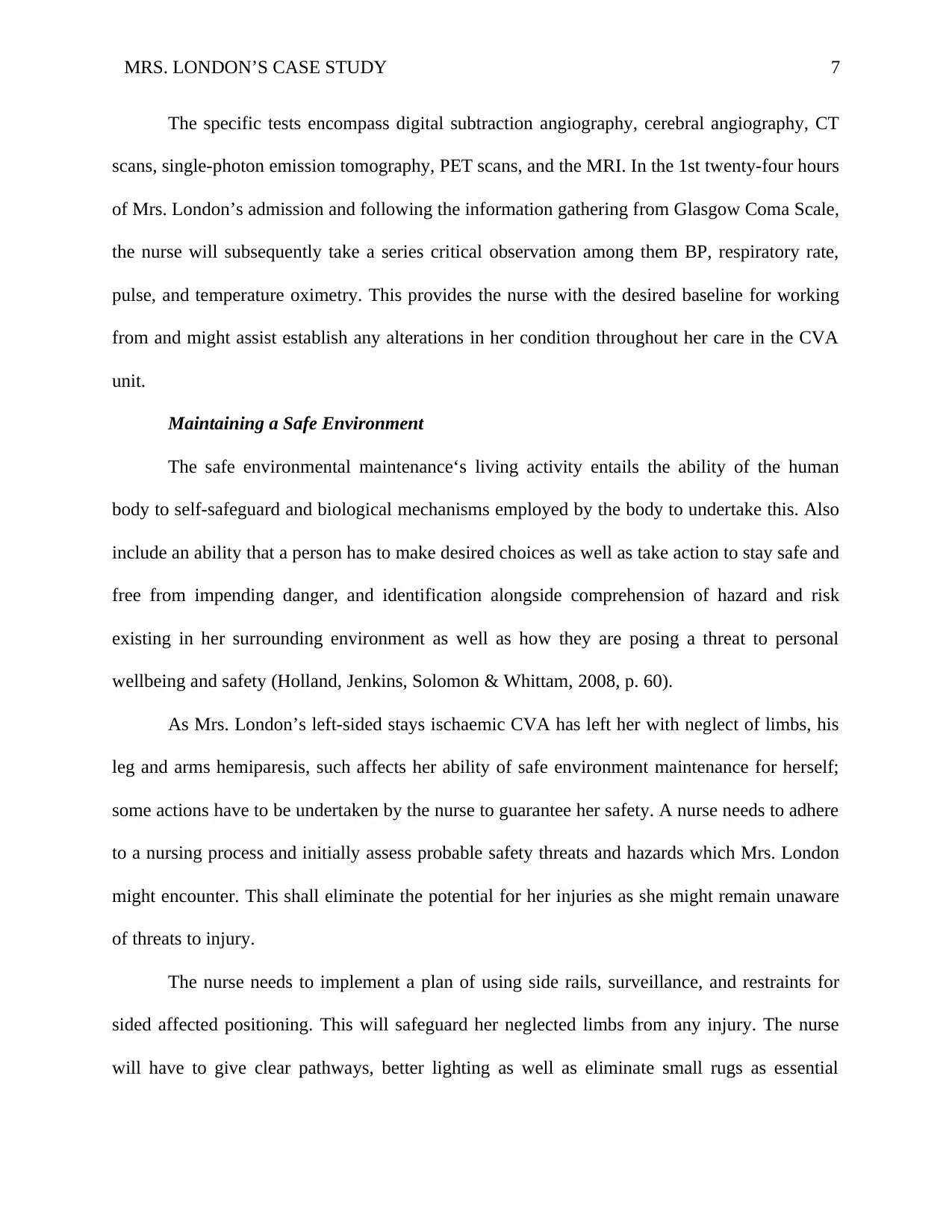
MRS. LONDON’S CASE STUDY 7
The specific tests encompass digital subtraction angiography, cerebral angiography, CT
scans, single-photon emission tomography, PET scans, and the MRI. In the 1st twenty-four hours
of Mrs. London’s admission and following the information gathering from Glasgow Coma Scale,
the nurse will subsequently take a series critical observation among them BP, respiratory rate,
pulse, and temperature oximetry. This provides the nurse with the desired baseline for working
from and might assist establish any alterations in her condition throughout her care in the CVA
unit.
Maintaining a Safe Environment
The safe environmental maintenance‘s living activity entails the ability of the human
body to self-safeguard and biological mechanisms employed by the body to undertake this. Also
include an ability that a person has to make desired choices as well as take action to stay safe and
free from impending danger, and identification alongside comprehension of hazard and risk
existing in her surrounding environment as well as how they are posing a threat to personal
wellbeing and safety (Holland, Jenkins, Solomon & Whittam, 2008, p. 60).
As Mrs. London’s left-sided stays ischaemic CVA has left her with neglect of limbs, his
leg and arms hemiparesis, such affects her ability of safe environment maintenance for herself;
some actions have to be undertaken by the nurse to guarantee her safety. A nurse needs to adhere
to a nursing process and initially assess probable safety threats and hazards which Mrs. London
might encounter. This shall eliminate the potential for her injuries as she might remain unaware
of threats to injury.
The nurse needs to implement a plan of using side rails, surveillance, and restraints for
sided affected positioning. This will safeguard her neglected limbs from any injury. The nurse
will have to give clear pathways, better lighting as well as eliminate small rugs as essential
The specific tests encompass digital subtraction angiography, cerebral angiography, CT
scans, single-photon emission tomography, PET scans, and the MRI. In the 1st twenty-four hours
of Mrs. London’s admission and following the information gathering from Glasgow Coma Scale,
the nurse will subsequently take a series critical observation among them BP, respiratory rate,
pulse, and temperature oximetry. This provides the nurse with the desired baseline for working
from and might assist establish any alterations in her condition throughout her care in the CVA
unit.
Maintaining a Safe Environment
The safe environmental maintenance‘s living activity entails the ability of the human
body to self-safeguard and biological mechanisms employed by the body to undertake this. Also
include an ability that a person has to make desired choices as well as take action to stay safe and
free from impending danger, and identification alongside comprehension of hazard and risk
existing in her surrounding environment as well as how they are posing a threat to personal
wellbeing and safety (Holland, Jenkins, Solomon & Whittam, 2008, p. 60).
As Mrs. London’s left-sided stays ischaemic CVA has left her with neglect of limbs, his
leg and arms hemiparesis, such affects her ability of safe environment maintenance for herself;
some actions have to be undertaken by the nurse to guarantee her safety. A nurse needs to adhere
to a nursing process and initially assess probable safety threats and hazards which Mrs. London
might encounter. This shall eliminate the potential for her injuries as she might remain unaware
of threats to injury.
The nurse needs to implement a plan of using side rails, surveillance, and restraints for
sided affected positioning. This will safeguard her neglected limbs from any injury. The nurse
will have to give clear pathways, better lighting as well as eliminate small rugs as essential
Paraphrase This Document
Need a fresh take? Get an instant paraphrase of this document with our AI Paraphraser
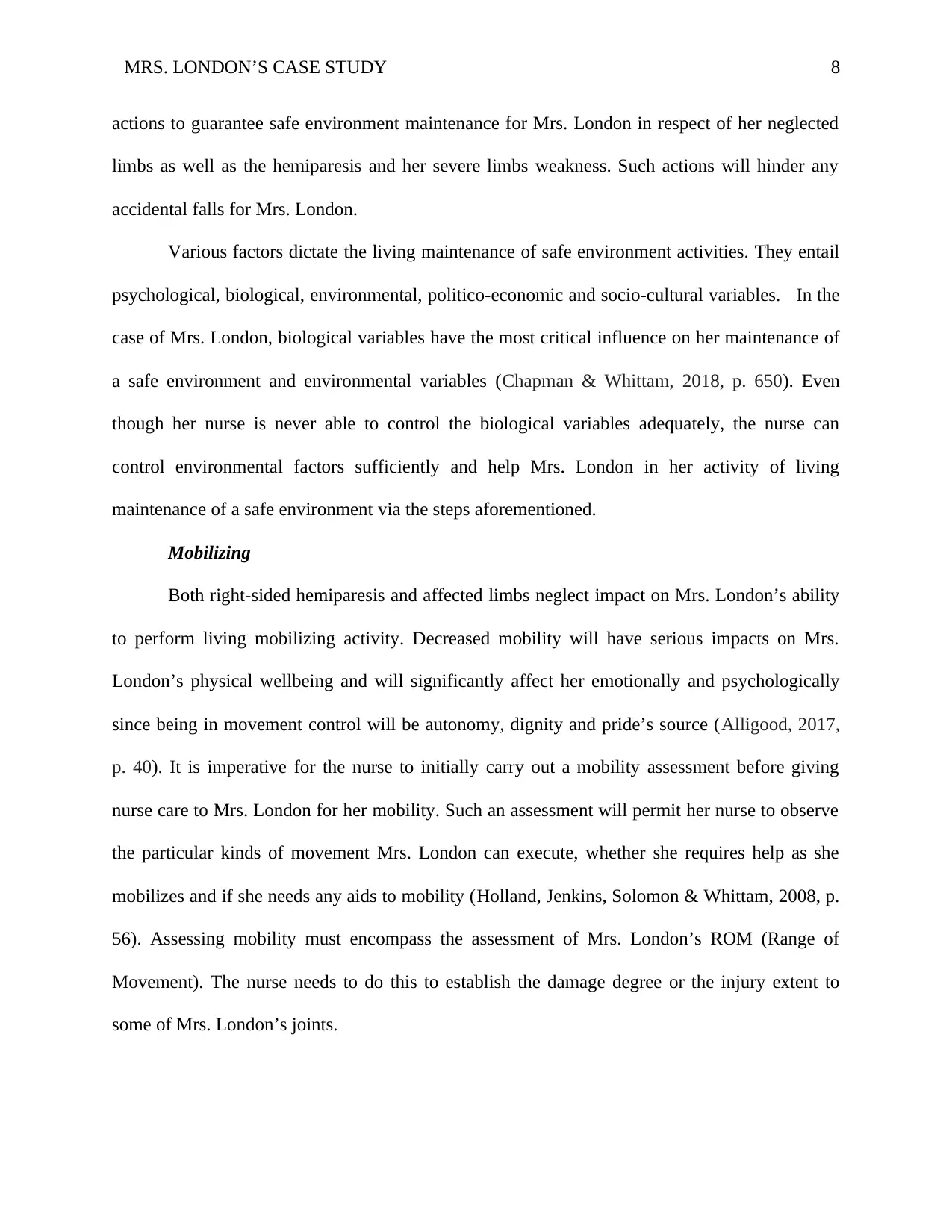
MRS. LONDON’S CASE STUDY 8
actions to guarantee safe environment maintenance for Mrs. London in respect of her neglected
limbs as well as the hemiparesis and her severe limbs weakness. Such actions will hinder any
accidental falls for Mrs. London.
Various factors dictate the living maintenance of safe environment activities. They entail
psychological, biological, environmental, politico-economic and socio-cultural variables. In the
case of Mrs. London, biological variables have the most critical influence on her maintenance of
a safe environment and environmental variables (Chapman & Whittam, 2018, p. 650). Even
though her nurse is never able to control the biological variables adequately, the nurse can
control environmental factors sufficiently and help Mrs. London in her activity of living
maintenance of a safe environment via the steps aforementioned.
Mobilizing
Both right-sided hemiparesis and affected limbs neglect impact on Mrs. London’s ability
to perform living mobilizing activity. Decreased mobility will have serious impacts on Mrs.
London’s physical wellbeing and will significantly affect her emotionally and psychologically
since being in movement control will be autonomy, dignity and pride’s source (Alligood, 2017,
p. 40). It is imperative for the nurse to initially carry out a mobility assessment before giving
nurse care to Mrs. London for her mobility. Such an assessment will permit her nurse to observe
the particular kinds of movement Mrs. London can execute, whether she requires help as she
mobilizes and if she needs any aids to mobility (Holland, Jenkins, Solomon & Whittam, 2008, p.
56). Assessing mobility must encompass the assessment of Mrs. London’s ROM (Range of
Movement). The nurse needs to do this to establish the damage degree or the injury extent to
some of Mrs. London’s joints.
actions to guarantee safe environment maintenance for Mrs. London in respect of her neglected
limbs as well as the hemiparesis and her severe limbs weakness. Such actions will hinder any
accidental falls for Mrs. London.
Various factors dictate the living maintenance of safe environment activities. They entail
psychological, biological, environmental, politico-economic and socio-cultural variables. In the
case of Mrs. London, biological variables have the most critical influence on her maintenance of
a safe environment and environmental variables (Chapman & Whittam, 2018, p. 650). Even
though her nurse is never able to control the biological variables adequately, the nurse can
control environmental factors sufficiently and help Mrs. London in her activity of living
maintenance of a safe environment via the steps aforementioned.
Mobilizing
Both right-sided hemiparesis and affected limbs neglect impact on Mrs. London’s ability
to perform living mobilizing activity. Decreased mobility will have serious impacts on Mrs.
London’s physical wellbeing and will significantly affect her emotionally and psychologically
since being in movement control will be autonomy, dignity and pride’s source (Alligood, 2017,
p. 40). It is imperative for the nurse to initially carry out a mobility assessment before giving
nurse care to Mrs. London for her mobility. Such an assessment will permit her nurse to observe
the particular kinds of movement Mrs. London can execute, whether she requires help as she
mobilizes and if she needs any aids to mobility (Holland, Jenkins, Solomon & Whittam, 2008, p.
56). Assessing mobility must encompass the assessment of Mrs. London’s ROM (Range of
Movement). The nurse needs to do this to establish the damage degree or the injury extent to
some of Mrs. London’s joints.
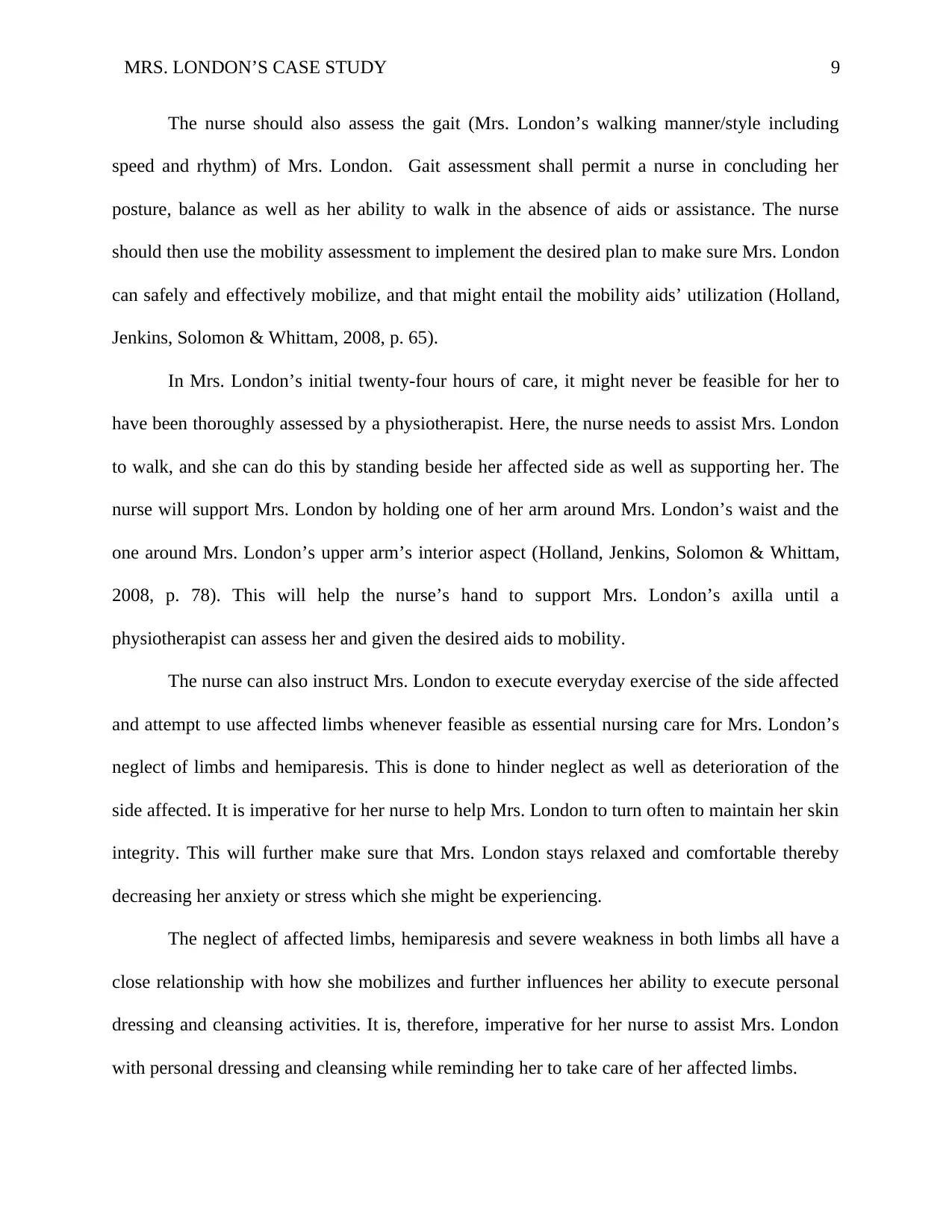
MRS. LONDON’S CASE STUDY 9
The nurse should also assess the gait (Mrs. London’s walking manner/style including
speed and rhythm) of Mrs. London. Gait assessment shall permit a nurse in concluding her
posture, balance as well as her ability to walk in the absence of aids or assistance. The nurse
should then use the mobility assessment to implement the desired plan to make sure Mrs. London
can safely and effectively mobilize, and that might entail the mobility aids’ utilization (Holland,
Jenkins, Solomon & Whittam, 2008, p. 65).
In Mrs. London’s initial twenty-four hours of care, it might never be feasible for her to
have been thoroughly assessed by a physiotherapist. Here, the nurse needs to assist Mrs. London
to walk, and she can do this by standing beside her affected side as well as supporting her. The
nurse will support Mrs. London by holding one of her arm around Mrs. London’s waist and the
one around Mrs. London’s upper arm’s interior aspect (Holland, Jenkins, Solomon & Whittam,
2008, p. 78). This will help the nurse’s hand to support Mrs. London’s axilla until a
physiotherapist can assess her and given the desired aids to mobility.
The nurse can also instruct Mrs. London to execute everyday exercise of the side affected
and attempt to use affected limbs whenever feasible as essential nursing care for Mrs. London’s
neglect of limbs and hemiparesis. This is done to hinder neglect as well as deterioration of the
side affected. It is imperative for her nurse to help Mrs. London to turn often to maintain her skin
integrity. This will further make sure that Mrs. London stays relaxed and comfortable thereby
decreasing her anxiety or stress which she might be experiencing.
The neglect of affected limbs, hemiparesis and severe weakness in both limbs all have a
close relationship with how she mobilizes and further influences her ability to execute personal
dressing and cleansing activities. It is, therefore, imperative for her nurse to assist Mrs. London
with personal dressing and cleansing while reminding her to take care of her affected limbs.
The nurse should also assess the gait (Mrs. London’s walking manner/style including
speed and rhythm) of Mrs. London. Gait assessment shall permit a nurse in concluding her
posture, balance as well as her ability to walk in the absence of aids or assistance. The nurse
should then use the mobility assessment to implement the desired plan to make sure Mrs. London
can safely and effectively mobilize, and that might entail the mobility aids’ utilization (Holland,
Jenkins, Solomon & Whittam, 2008, p. 65).
In Mrs. London’s initial twenty-four hours of care, it might never be feasible for her to
have been thoroughly assessed by a physiotherapist. Here, the nurse needs to assist Mrs. London
to walk, and she can do this by standing beside her affected side as well as supporting her. The
nurse will support Mrs. London by holding one of her arm around Mrs. London’s waist and the
one around Mrs. London’s upper arm’s interior aspect (Holland, Jenkins, Solomon & Whittam,
2008, p. 78). This will help the nurse’s hand to support Mrs. London’s axilla until a
physiotherapist can assess her and given the desired aids to mobility.
The nurse can also instruct Mrs. London to execute everyday exercise of the side affected
and attempt to use affected limbs whenever feasible as essential nursing care for Mrs. London’s
neglect of limbs and hemiparesis. This is done to hinder neglect as well as deterioration of the
side affected. It is imperative for her nurse to help Mrs. London to turn often to maintain her skin
integrity. This will further make sure that Mrs. London stays relaxed and comfortable thereby
decreasing her anxiety or stress which she might be experiencing.
The neglect of affected limbs, hemiparesis and severe weakness in both limbs all have a
close relationship with how she mobilizes and further influences her ability to execute personal
dressing and cleansing activities. It is, therefore, imperative for her nurse to assist Mrs. London
with personal dressing and cleansing while reminding her to take care of her affected limbs.
⊘ This is a preview!⊘
Do you want full access?
Subscribe today to unlock all pages.

Trusted by 1+ million students worldwide
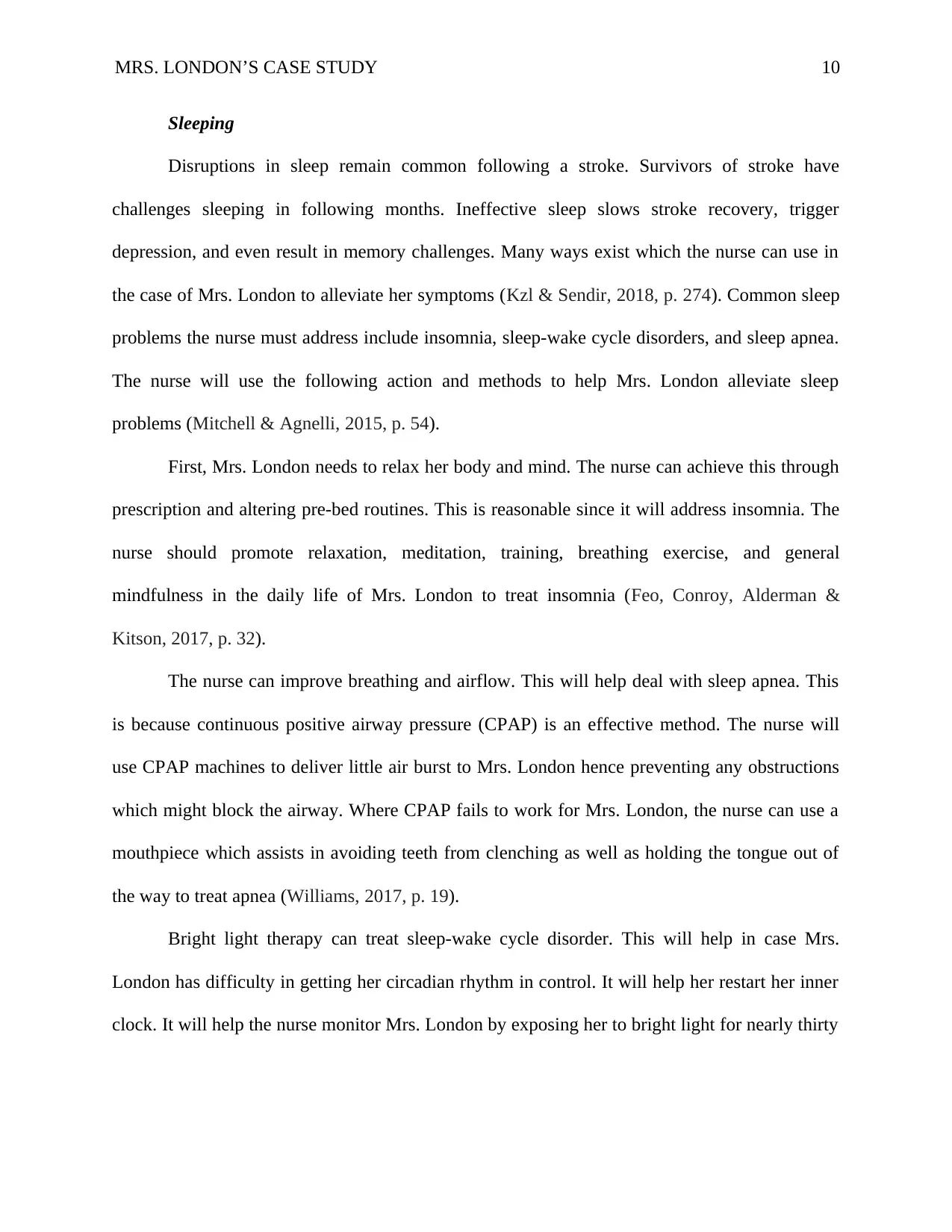
MRS. LONDON’S CASE STUDY 10
Sleeping
Disruptions in sleep remain common following a stroke. Survivors of stroke have
challenges sleeping in following months. Ineffective sleep slows stroke recovery, trigger
depression, and even result in memory challenges. Many ways exist which the nurse can use in
the case of Mrs. London to alleviate her symptoms (Kzl & Sendir, 2018, p. 274). Common sleep
problems the nurse must address include insomnia, sleep-wake cycle disorders, and sleep apnea.
The nurse will use the following action and methods to help Mrs. London alleviate sleep
problems (Mitchell & Agnelli, 2015, p. 54).
First, Mrs. London needs to relax her body and mind. The nurse can achieve this through
prescription and altering pre-bed routines. This is reasonable since it will address insomnia. The
nurse should promote relaxation, meditation, training, breathing exercise, and general
mindfulness in the daily life of Mrs. London to treat insomnia (Feo, Conroy, Alderman &
Kitson, 2017, p. 32).
The nurse can improve breathing and airflow. This will help deal with sleep apnea. This
is because continuous positive airway pressure (CPAP) is an effective method. The nurse will
use CPAP machines to deliver little air burst to Mrs. London hence preventing any obstructions
which might block the airway. Where CPAP fails to work for Mrs. London, the nurse can use a
mouthpiece which assists in avoiding teeth from clenching as well as holding the tongue out of
the way to treat apnea (Williams, 2017, p. 19).
Bright light therapy can treat sleep-wake cycle disorder. This will help in case Mrs.
London has difficulty in getting her circadian rhythm in control. It will help her restart her inner
clock. It will help the nurse monitor Mrs. London by exposing her to bright light for nearly thirty
Sleeping
Disruptions in sleep remain common following a stroke. Survivors of stroke have
challenges sleeping in following months. Ineffective sleep slows stroke recovery, trigger
depression, and even result in memory challenges. Many ways exist which the nurse can use in
the case of Mrs. London to alleviate her symptoms (Kzl & Sendir, 2018, p. 274). Common sleep
problems the nurse must address include insomnia, sleep-wake cycle disorders, and sleep apnea.
The nurse will use the following action and methods to help Mrs. London alleviate sleep
problems (Mitchell & Agnelli, 2015, p. 54).
First, Mrs. London needs to relax her body and mind. The nurse can achieve this through
prescription and altering pre-bed routines. This is reasonable since it will address insomnia. The
nurse should promote relaxation, meditation, training, breathing exercise, and general
mindfulness in the daily life of Mrs. London to treat insomnia (Feo, Conroy, Alderman &
Kitson, 2017, p. 32).
The nurse can improve breathing and airflow. This will help deal with sleep apnea. This
is because continuous positive airway pressure (CPAP) is an effective method. The nurse will
use CPAP machines to deliver little air burst to Mrs. London hence preventing any obstructions
which might block the airway. Where CPAP fails to work for Mrs. London, the nurse can use a
mouthpiece which assists in avoiding teeth from clenching as well as holding the tongue out of
the way to treat apnea (Williams, 2017, p. 19).
Bright light therapy can treat sleep-wake cycle disorder. This will help in case Mrs.
London has difficulty in getting her circadian rhythm in control. It will help her restart her inner
clock. It will help the nurse monitor Mrs. London by exposing her to bright light for nearly thirty
Paraphrase This Document
Need a fresh take? Get an instant paraphrase of this document with our AI Paraphraser
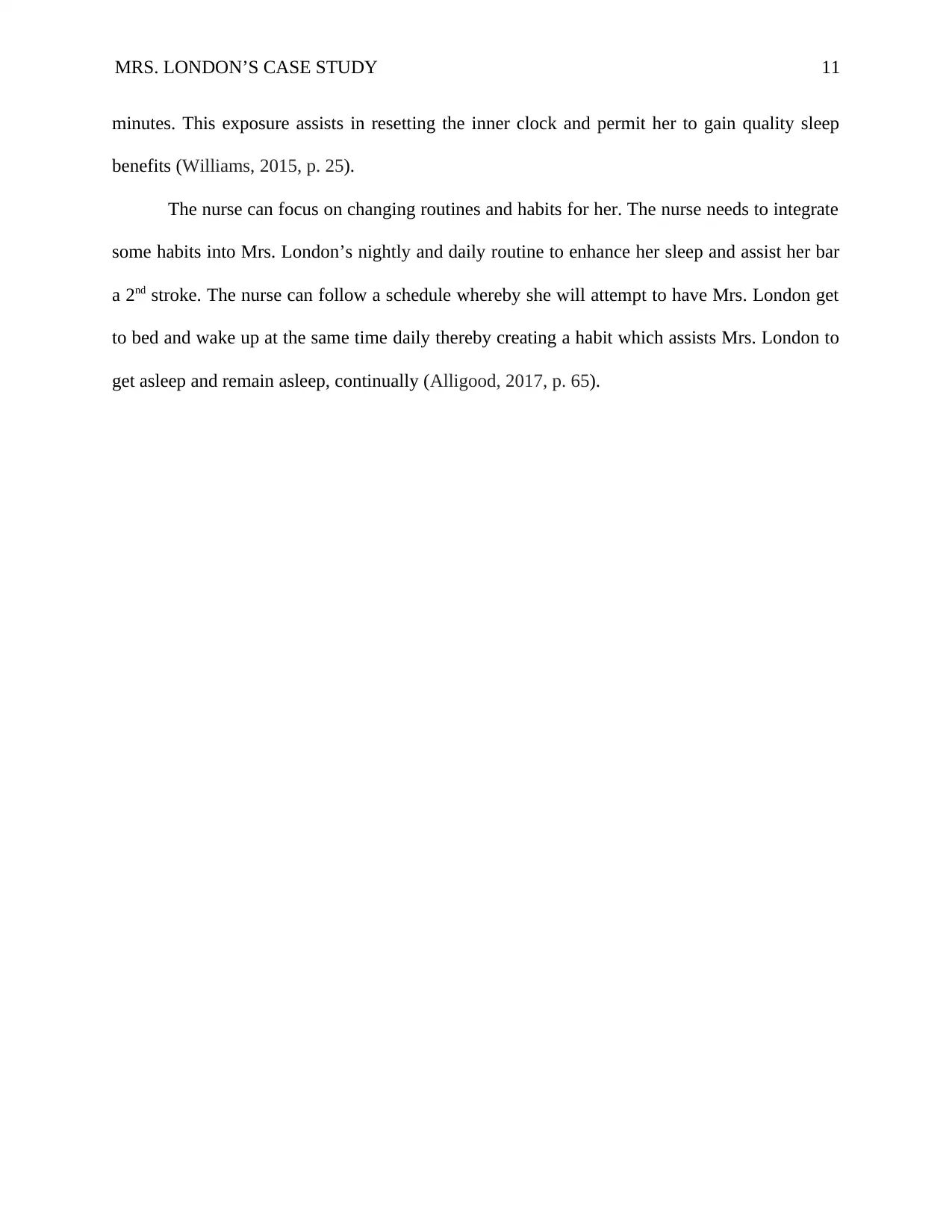
MRS. LONDON’S CASE STUDY 11
minutes. This exposure assists in resetting the inner clock and permit her to gain quality sleep
benefits (Williams, 2015, p. 25).
The nurse can focus on changing routines and habits for her. The nurse needs to integrate
some habits into Mrs. London’s nightly and daily routine to enhance her sleep and assist her bar
a 2nd stroke. The nurse can follow a schedule whereby she will attempt to have Mrs. London get
to bed and wake up at the same time daily thereby creating a habit which assists Mrs. London to
get asleep and remain asleep, continually (Alligood, 2017, p. 65).
minutes. This exposure assists in resetting the inner clock and permit her to gain quality sleep
benefits (Williams, 2015, p. 25).
The nurse can focus on changing routines and habits for her. The nurse needs to integrate
some habits into Mrs. London’s nightly and daily routine to enhance her sleep and assist her bar
a 2nd stroke. The nurse can follow a schedule whereby she will attempt to have Mrs. London get
to bed and wake up at the same time daily thereby creating a habit which assists Mrs. London to
get asleep and remain asleep, continually (Alligood, 2017, p. 65).
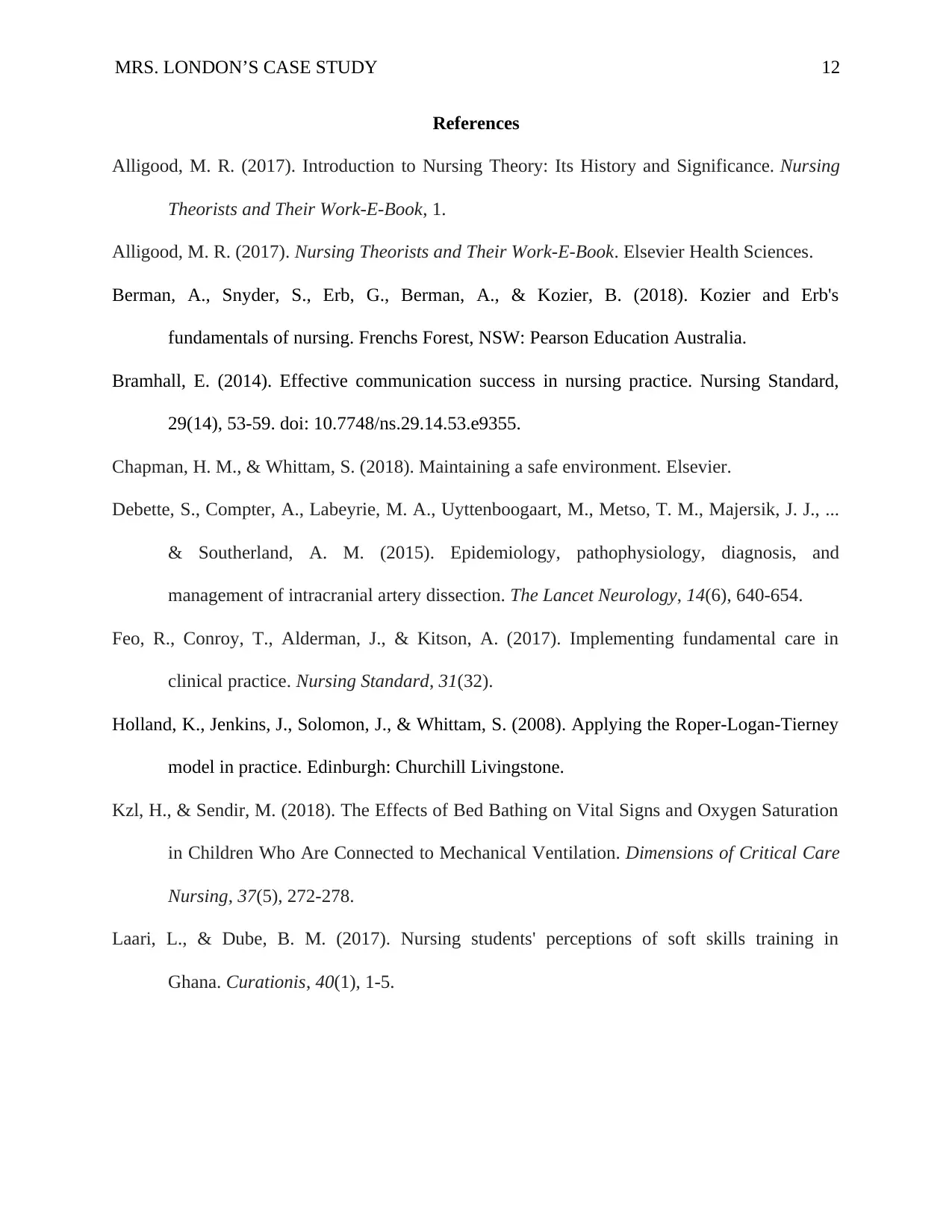
MRS. LONDON’S CASE STUDY 12
References
Alligood, M. R. (2017). Introduction to Nursing Theory: Its History and Significance. Nursing
Theorists and Their Work-E-Book, 1.
Alligood, M. R. (2017). Nursing Theorists and Their Work-E-Book. Elsevier Health Sciences.
Berman, A., Snyder, S., Erb, G., Berman, A., & Kozier, B. (2018). Kozier and Erb's
fundamentals of nursing. Frenchs Forest, NSW: Pearson Education Australia.
Bramhall, E. (2014). Effective communication success in nursing practice. Nursing Standard,
29(14), 53-59. doi: 10.7748/ns.29.14.53.e9355.
Chapman, H. M., & Whittam, S. (2018). Maintaining a safe environment. Elsevier.
Debette, S., Compter, A., Labeyrie, M. A., Uyttenboogaart, M., Metso, T. M., Majersik, J. J., ...
& Southerland, A. M. (2015). Epidemiology, pathophysiology, diagnosis, and
management of intracranial artery dissection. The Lancet Neurology, 14(6), 640-654.
Feo, R., Conroy, T., Alderman, J., & Kitson, A. (2017). Implementing fundamental care in
clinical practice. Nursing Standard, 31(32).
Holland, K., Jenkins, J., Solomon, J., & Whittam, S. (2008). Applying the Roper-Logan-Tierney
model in practice. Edinburgh: Churchill Livingstone.
Kzl, H., & Sendir, M. (2018). The Effects of Bed Bathing on Vital Signs and Oxygen Saturation
in Children Who Are Connected to Mechanical Ventilation. Dimensions of Critical Care
Nursing, 37(5), 272-278.
Laari, L., & Dube, B. M. (2017). Nursing students' perceptions of soft skills training in
Ghana. Curationis, 40(1), 1-5.
References
Alligood, M. R. (2017). Introduction to Nursing Theory: Its History and Significance. Nursing
Theorists and Their Work-E-Book, 1.
Alligood, M. R. (2017). Nursing Theorists and Their Work-E-Book. Elsevier Health Sciences.
Berman, A., Snyder, S., Erb, G., Berman, A., & Kozier, B. (2018). Kozier and Erb's
fundamentals of nursing. Frenchs Forest, NSW: Pearson Education Australia.
Bramhall, E. (2014). Effective communication success in nursing practice. Nursing Standard,
29(14), 53-59. doi: 10.7748/ns.29.14.53.e9355.
Chapman, H. M., & Whittam, S. (2018). Maintaining a safe environment. Elsevier.
Debette, S., Compter, A., Labeyrie, M. A., Uyttenboogaart, M., Metso, T. M., Majersik, J. J., ...
& Southerland, A. M. (2015). Epidemiology, pathophysiology, diagnosis, and
management of intracranial artery dissection. The Lancet Neurology, 14(6), 640-654.
Feo, R., Conroy, T., Alderman, J., & Kitson, A. (2017). Implementing fundamental care in
clinical practice. Nursing Standard, 31(32).
Holland, K., Jenkins, J., Solomon, J., & Whittam, S. (2008). Applying the Roper-Logan-Tierney
model in practice. Edinburgh: Churchill Livingstone.
Kzl, H., & Sendir, M. (2018). The Effects of Bed Bathing on Vital Signs and Oxygen Saturation
in Children Who Are Connected to Mechanical Ventilation. Dimensions of Critical Care
Nursing, 37(5), 272-278.
Laari, L., & Dube, B. M. (2017). Nursing students' perceptions of soft skills training in
Ghana. Curationis, 40(1), 1-5.
⊘ This is a preview!⊘
Do you want full access?
Subscribe today to unlock all pages.

Trusted by 1+ million students worldwide
1 out of 14
Your All-in-One AI-Powered Toolkit for Academic Success.
+13062052269
info@desklib.com
Available 24*7 on WhatsApp / Email
![[object Object]](/_next/static/media/star-bottom.7253800d.svg)
Unlock your academic potential
Copyright © 2020–2025 A2Z Services. All Rights Reserved. Developed and managed by ZUCOL.


